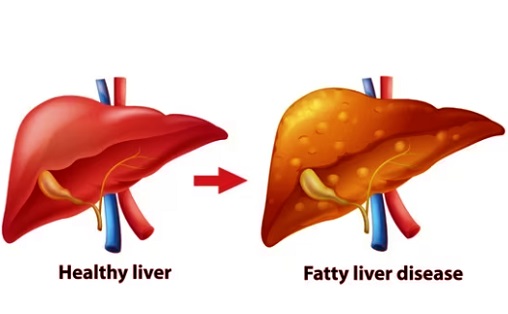Nikhil Prasad Fact checked by:Thailand Medical News Team Dec 31, 2024 10 months, 1 week, 7 hours, 25 minutes ago
Medical News: Fatty Liver Disease: A Global Health Concern
Fatty liver disease, particularly Non-Alcoholic Fatty Liver Disease (NAFLD), has emerged as the leading cause of chronic liver issues worldwide. Researchers from the University of Medicine and Pharmacy of Craiova in Romania, including experts from the departments of internal medicine, neurology, gastroenterology, and endocrinology, highlight the critical nature of this condition. It affects approximately 25% of the global population and is often overlooked despite its significant health impacts.
 New Perspectives on Fatty Liver Disease Awareness
New Perspectives on Fatty Liver Disease Awareness
This
Medical News report explores how NAFLD, now also referred to as Metabolic-Associated Steatotic Liver Disease (MASLD), is linked to various metabolic and systemic conditions. The study findings emphasize the importance of increased awareness and advanced diagnostic strategies to combat the widespread prevalence of this disease.
What is Fatty Liver Disease?
NAFLD refers to the accumulation of fat in more than 5% of liver cells, unrelated to excessive alcohol consumption or other secondary causes of chronic liver diseases. It is a progressive condition that begins as simple steatosis but may develop into non-alcoholic steatohepatitis (NASH), characterized by liver inflammation, fibrosis, and potentially liver cirrhosis. Alarmingly, NASH can also progress to hepatocellular carcinoma (HCC), even in patients without fibrosis or cirrhosis.
Research indicates that NAFLD is a major contributor to cardiovascular complications and mortality. Approximately 57-74% of obese individuals and nearly half of those with type 2 diabetes are diagnosed with NAFLD. Moreover, about 25% of patients with NAFLD eventually progress to NASH, highlighting the need for early detection and intervention.
Challenges in Diagnosis
Detecting NAFLD poses a significant challenge for clinicians. Imaging techniques like ultrasound, computed tomography (CT), and magnetic resonance imaging (MRI) serve as the first line of diagnostic tools. Abdominal ultrasound, being cost-effective and widely accessible, is often the preferred method. However, its sensitivity is limited, particularly in detecting mild steatosis or in patients with a high body mass index (BMI).
Non-invasive tools such as the FibroScan device, which measures liver stiffness and fat content, have largely replaced invasive liver biopsies. Scoring systems like the NAFLD Fibrosis Score (NFS) and Fibrosis-4 (FIB-4) are also used to estimate the risk of advanced fibrosis. Yet, these methods have their limitations, and liver biopsies remain the gold standard in uncertain cases.
A Shift in Terminology
To better reflect its metabolic origins, the term NAFLD has recently been replaced by MASLD. This new terminology recognizes that the disease is closely tied to metabolic syndrome, which includes obesity, type 2 diabetes, and dyslipidemia. MASLD encompasses a broader spectrum of conditions, including alcohol-associated liver disease (MetALD) and steatosis caused by specific factors
like medications or genetic disorders.
The updated nomenclature aims to eliminate the stigma associated with terms like "non-alcoholic" and focuses on the metabolic dysfunction underlying the disease. This redefinition underscores the importance of identifying MASLD as a key diagnosis linked to various systemic disorders.
Study Insights: A Multifaceted Condition
The researchers from Craiova provide valuable insights into the multifactorial nature of MASLD. They describe how the disease is associated with:
-Metabolic Syndrome: A cluster of conditions including insulin resistance, obesity, and high cholesterol levels.
-Endocrine Disorders: Conditions such as hypothyroidism, polycystic ovary syndrome (PCOS), and growth hormone deficiencies are often linked to MASLD.
-Cardiovascular Diseases (CVD): MASLD significantly increases the risk of heart-related issues, making it a crucial consideration for cardiologists.
-Gastrointestinal Complications: The disease also intersects with other liver conditions, including hepatitis B and C, as well as gastrointestinal disorders like inflammatory bowel diseases.
By addressing these interrelated factors, the study emphasizes the need for collaborative efforts among medical specialists to improve patient outcomes.
Key Findings: Interplay Between MASLD and Other Conditions
The study highlights several critical findings. Patients with MASLD are more likely to suffer from insulin resistance, leading to type 2 diabetes. Elevated levels of free fatty acids and inflammatory markers exacerbate this condition, creating a vicious cycle that accelerates disease progression.
Cardiovascular risks are another major concern. MASLD contributes to subclinical atherosclerosis, endothelial dysfunction, and increased levels of pro-inflammatory cytokines, all of which elevate the likelihood of heart attacks and strokes. This underscores the need for integrated care approaches to address both liver and cardiovascular health.
Additionally, endocrine disorders such as hypothyroidism and PCOS are frequently associated with MASLD. Women with PCOS, particularly those with hyperandrogenism, face a significantly higher risk of developing severe liver damage. Similarly, patients with growth hormone deficiencies or hypothyroidism often exhibit lipid metabolism disturbances that exacerbate MASLD.
Conclusions and Implications for Practice
Addressing MASLD requires a comprehensive approach. Clinicians must focus on early detection through non-invasive methods and consider the broader metabolic context of each patient. Lifestyle interventions, including weight loss and dietary modifications, play a pivotal role in managing the disease.
The researchers advocate for a multidisciplinary strategy involving gastroenterologists, endocrinologists, cardiologists, and primary care physicians. Such collaboration is essential to identify at-risk individuals and implement effective treatment plans. Moreover, public health initiatives aimed at raising awareness about MASLD can help mitigate its impact on global health systems.
In conclusion, MASLD represents a complex and evolving public health challenge. By adopting a holistic and collaborative approach, healthcare providers can better address the needs of patients and reduce the burden of this disease.
The study findings were published in the peer-reviewed journal: Gastroenterology Insights.
https://www.mdpi.com/2036-7422/15/4/71
For the latest on Fatty Liver Disease, keep on logging to Thailand
Medical News.
Read Also:
https://www.thailandmedical.news/news/fructose-sweeteners-university-of-california-study-shows-that-excessive-fructose-intake-may-cause-leaky-gut-which-in-turn-leads-to-fatty-liver-disease
https://www.thailandmedical.news/news/fatty-liver-disease-increases-risk-of-covid-19-hospitalization-but-majority-do-not-even-know-they-have-fatty-liver-disease
https://www.thailandmedical.news/news/researchers-alarmingly-find-that-metabolic-associated-fatty-liver-disease-mafld-may-be-a-prevalent-long-covid-manifestation
https://www.thailandmedical.news/news/covid-19-news-fatty-acids-impact-ace2-receptor-expression-in-metabolic-dysfunction-associated-steatotic-liver-disease
https://www.thailandmedical.news/news/metformin-shows-promise-in-fatty-liver-disease-and-lowering-blood-fat-levels
https://www.thailandmedical.news/news/natural-compound-from-waterlily-shows-promise-in-fighting-fatty-liver-disease
